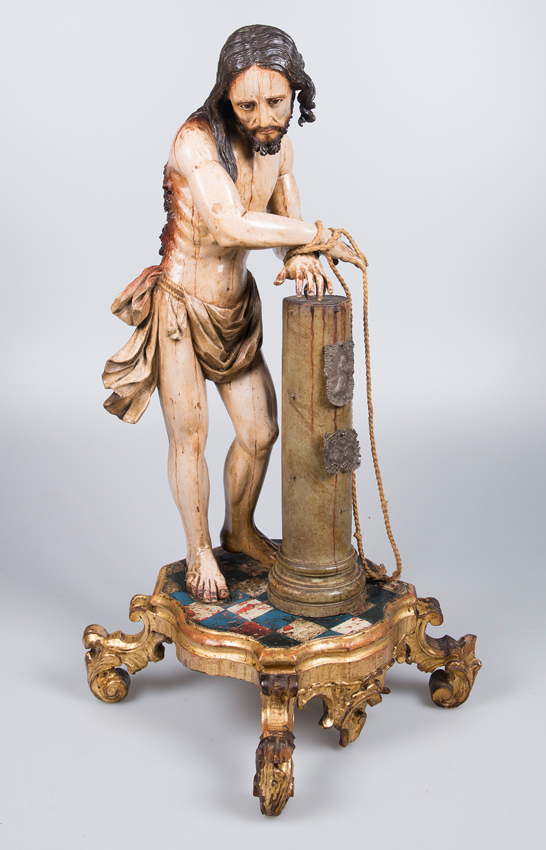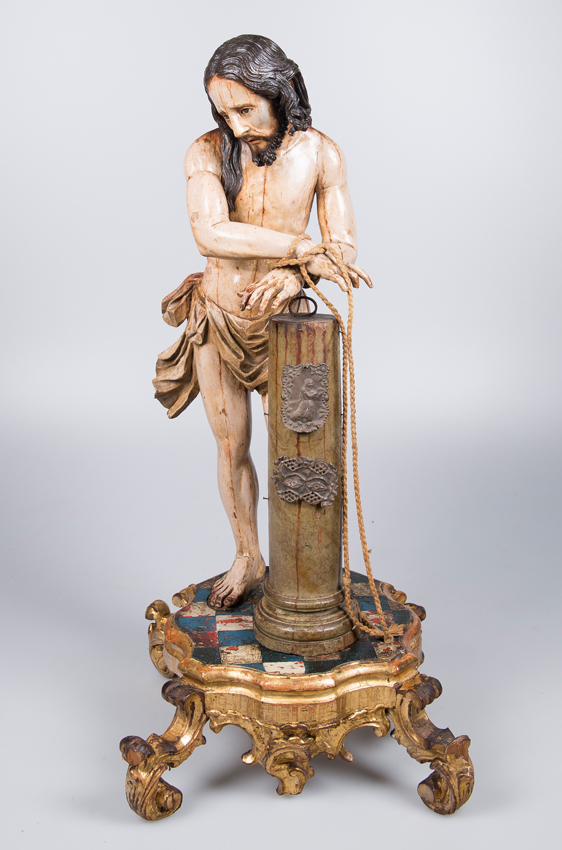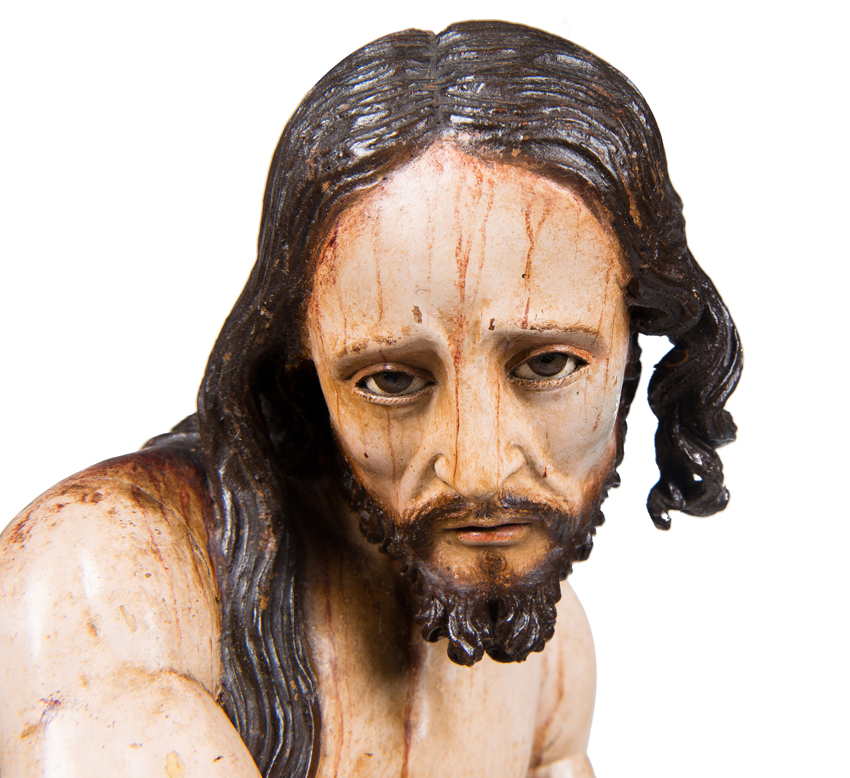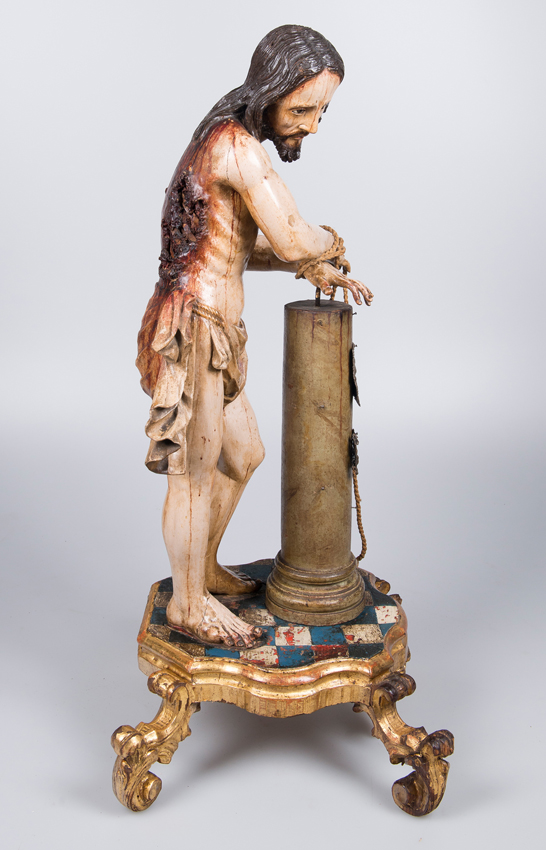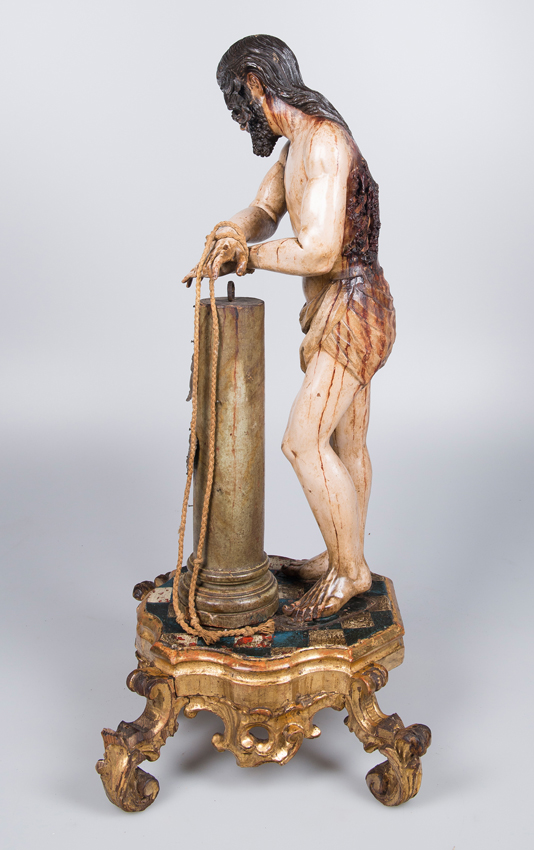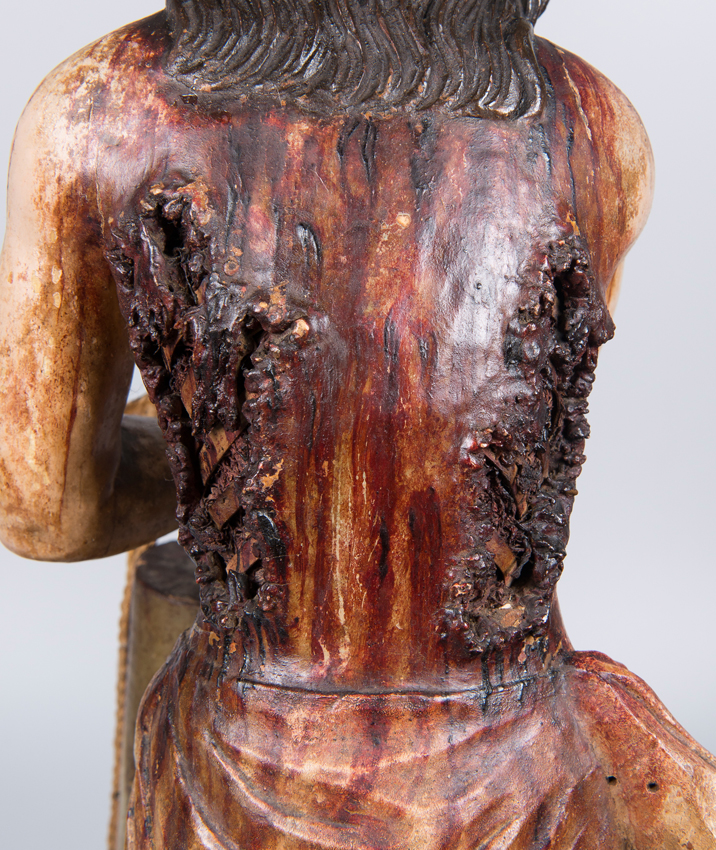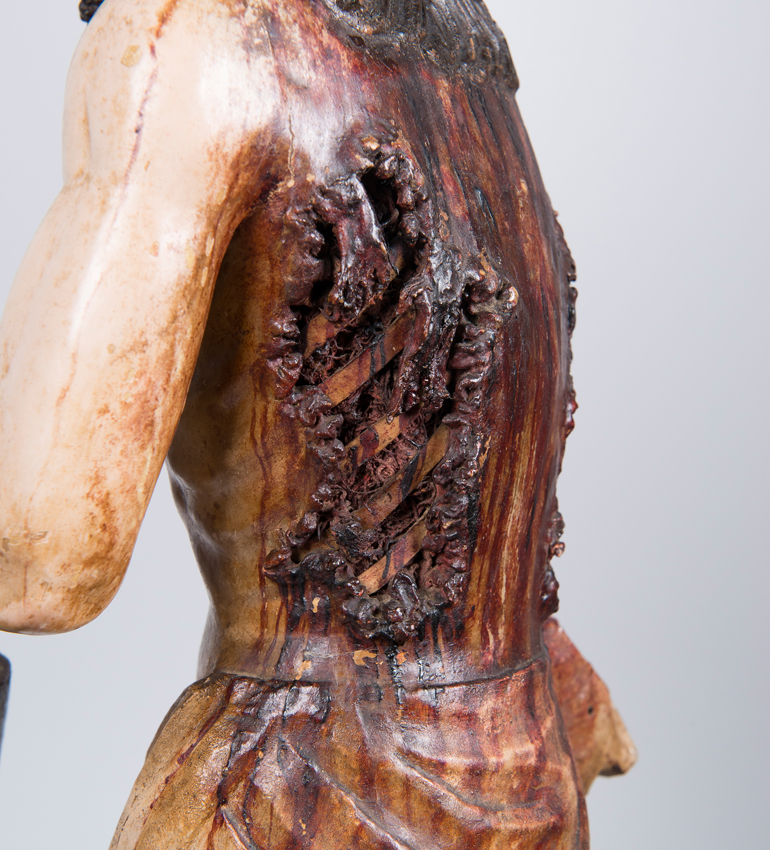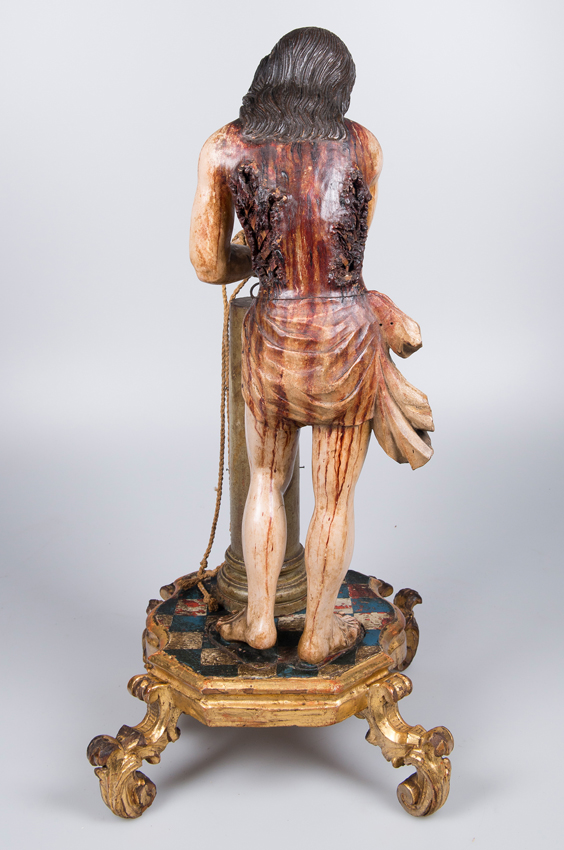150
Attributed to Baltazar Gavilán (Peru, 18th century)
Attributed to Baltazar Gavilán (Peru, 18th century)
"Christ Bound to the Column"
Carved, polychromed, and gilded wooden sculpture, with glass eyes. On its original carved and gilded wooden base.
Column with two silver ex-votos.
71 x 32 x 31 cm.
Gavilán is particularly renowned for his sculptures of Ecce Homo. We are possibly looking at one of the most impressive, raw, and dramatic sculptures we have ever presented in our auctions.
The sculptor’s skill is divine; he possesses an undeniable knowledge of human anatomy and, through it, he carves an image that tears at the soul, presenting the suffering that Jesus endured without sparing the slightest detail.
The face, marked by pain, with prominent cheekbones, gaunt features, and an expression somewhere between dejection and disbelief, conveys both acceptance and anguish. It stirs a feeling of devotion, of closeness and compassion, in the faithful—who contemplate a Jesus who, though the Son of God, is portrayed as one of them, human and subjected to the greatest torments.
His hair falls in long locks, some separated to suggest movement, and the beard is slightly parted at the center—features also found in other Ecce Homo sculptures by Gavilán.
The body, bound to the column in a slight twist, is an anatomical study of perfect proportions. The arms highlight strong and muscular shoulders and forearms, just as the legs exhibit well-shaped thighs and calves. The hands, with fine and slender fingers, rest crossed over each other on the column.
The loincloth covering Jesus is, in itself, a sculptural masterpiece, composed of multiple folds falling in all directions.
All of this is pure beauty—but when we behold Christ’s back, the dramatic intensity is such that it is nearly impossible to remain unmoved.
The back, completely flayed, raw, and torn by the lashes received, evokes visceral pain.
Gavilán does not conceal the horror; rather, he transmits the terror that Jesus had to endure on the road to Calvary with raw power, even masterfully sculpting the exposed ribs.
Absolutely every element of this sculpture speaks of fascinating quality and craftsmanship.
The Ecce Homo and Christ at the Column sculptures in the Church of San Agustín in Lima are comparable to this piece.
His most iconic work is The Archer of Death, where, just as in our sculpture, Gavilán delivers a masterful lesson in anatomy. This representation of Death with a scythe presided over the Holy Thursday processions of the Augustinian fathers until shortly after 1824.
As we read in the entry on Baltasar Gavilán written by historian Luis Eduardo Wuffarden for the website of the Real Academia de la Historia Hispánica:
"A mestizo artisan according to traditional accounts, Gavilán is said to have been a fugitive from justice who sought refuge in the Convent of San Francisco around 1734–1738. He was required to carve an equestrian sculpture of King Philip V to receive a pardon from Viceroy García Sarmiento de Sotomayor. This piece was placed atop the arch of the stone bridge over the Rímac River but was destroyed when it collapsed during the 1746 earthquake.
During his time in San Francisco, Gavilán reportedly dedicated himself to carving nativity figures and a celebrated Virgin of Sorrows, which could be the one still housed today in the Franciscan church. According to the same legend, the artist died in 1753 after drunkenly entering his room and confronting his own newly completed sculpture of Death, depicted as an archer skeleton, commissioned by the Convent of San Agustín.
His work is characterized by a stark realism that defied the conventions imposed by Spanish masters of the previous century, representing a decisive renewal for the Lima school of sculpture in his time."
Reference Bibliography:
https://historia-hispanica.rah.es/biografias/19013-baltasar-gavilan
Attributed to Baltazar Gavilán (Peru, 18th century)
"Christ Bound to the Column"
Carved, polychromed, and gilded wooden sculpture, with glass eyes. On its original carved and gilded wooden base.
Column with two silver ex-votos.
71 x 32 x 31 cm.
Gavilán is particularly renowned for his sculptures of Ecce Homo. We are possibly looking at one of the most impressive, raw, and dramatic sculptures we have ever presented in our auctions.
The sculptor’s skill is divine; he possesses an undeniable knowledge of human anatomy and, through it, he carves an image that tears at the soul, presenting the suffering that Jesus endured without sparing the slightest detail.
The face, marked by pain, with prominent cheekbones, gaunt features, and an expression somewhere between dejection and disbelief, conveys both acceptance and anguish. It stirs a feeling of devotion, of closeness and compassion, in the faithful—who contemplate a Jesus who, though the Son of God, is portrayed as one of them, human and subjected to the greatest torments.
His hair falls in long locks, some separated to suggest movement, and the beard is slightly parted at the center—features also found in other Ecce Homo sculptures by Gavilán.
The body, bound to the column in a slight twist, is an anatomical study of perfect proportions. The arms highlight strong and muscular shoulders and forearms, just as the legs exhibit well-shaped thighs and calves. The hands, with fine and slender fingers, rest crossed over each other on the column.
The loincloth covering Jesus is, in itself, a sculptural masterpiece, composed of multiple folds falling in all directions.
All of this is pure beauty—but when we behold Christ’s back, the dramatic intensity is such that it is nearly impossible to remain unmoved.
The back, completely flayed, raw, and torn by the lashes received, evokes visceral pain.
Gavilán does not conceal the horror; rather, he transmits the terror that Jesus had to endure on the road to Calvary with raw power, even masterfully sculpting the exposed ribs.
Absolutely every element of this sculpture speaks of fascinating quality and craftsmanship.
The Ecce Homo and Christ at the Column sculptures in the Church of San Agustín in Lima are comparable to this piece.
His most iconic work is The Archer of Death, where, just as in our sculpture, Gavilán delivers a masterful lesson in anatomy. This representation of Death with a scythe presided over the Holy Thursday processions of the Augustinian fathers until shortly after 1824.
As we read in the entry on Baltasar Gavilán written by historian Luis Eduardo Wuffarden for the website of the Real Academia de la Historia Hispánica:
"A mestizo artisan according to traditional accounts, Gavilán is said to have been a fugitive from justice who sought refuge in the Convent of San Francisco around 1734–1738. He was required to carve an equestrian sculpture of King Philip V to receive a pardon from Viceroy García Sarmiento de Sotomayor. This piece was placed atop the arch of the stone bridge over the Rímac River but was destroyed when it collapsed during the 1746 earthquake.
During his time in San Francisco, Gavilán reportedly dedicated himself to carving nativity figures and a celebrated Virgin of Sorrows, which could be the one still housed today in the Franciscan church. According to the same legend, the artist died in 1753 after drunkenly entering his room and confronting his own newly completed sculpture of Death, depicted as an archer skeleton, commissioned by the Convent of San Agustín.
His work is characterized by a stark realism that defied the conventions imposed by Spanish masters of the previous century, representing a decisive renewal for the Lima school of sculpture in his time."
Reference Bibliography:
https://historia-hispanica.rah.es/biografias/19013-baltasar-gavilan
Vanitas, Parables and Devotions
Sale Date(s)
Venue Address
General delivery information available from the auctioneer
The purchase price includes the delivery of the lots in the venue of the auction. Transporting to other destinations is at the own risk of the client. The customer must contact "LST", to give the corresponding instructions for such transporting. "LST" is not responsible for the packaging or any accident incurred during transportation.
Important Information
Terms & Conditions
CONDITIONS OF THE AUCTION:
I. REGISTRATION. To bid in the room customers must register at the beginning, filling out a form and picking a number that will identify them during the auction. Customers may be required to register in bank references or other guarantee system and if they do not prove the solvency "LST" will not accept bids and award the auction.
II. WRITTEN BIDS. "LST" will accept written bids, which will be formalized in the form provided by the room until the day before the auction. In such auctions, the room will bid in name of the client until the maximum stated in the offer and always at the lowest possible price. If there are two or more bids for the same amount, the one placed first will have the priority. Written bids received in advance, will have priority on the day of the auction.
III. TELEPHONE BIDS. "LST" will allow telephone bids, if interested people contact "LST" days before the auction providing personal data, ID card and the phone number which will be used by the staff of "LST" to call at the time of the auction. The buyer, within all the legal rights is making an offer for the asking price, when applies for telephone bid. "LST" will not take responsibility for any technical defects beyond its control, which may prevent to contact successfully the bidder during the auction.
IV. AUCTIONEER. The auction will be conducted by an auctioneer, director of the auction will be judge and arbitrator of it with full authority in its development, will award the lots to the highest bidder and is able to settle any controversy concerning lots sale, reject bids, divide lots or group them and remover objects from the room. Will be able to, if it is deemed suitable, not accept bids on the auction. His decision will be unappealable.
V. SALE OF LOTS. The lots are awarded to the highest bidder. Once the auctioneer blows the hammer, the buyer becomes responsible of the lot purchased, exempting "LST" of liability to for any damage and / or accidents that may occur. No refunds of lots.
VI. STARTING PRICE. The amount shown in the catalogue as the starting price for each lot will be, as a rule, the minimum selling price, except for exceptional cases where a reservation may be agreed upon with the seller or it set discretionary by the room.
VII. SCALE OF BIDS. The bids are set according to the following scale:
From 50.-€ to 200.-€…………………………………………..at 10.-€
From 200.-€ to 500.-€…………………………………… …25 in 25.-€
From 500.-€ to 1.000.-€………………………………..…..….50 in 50.-€
From 1.000.-€ to 2.000.-€………………………………..…100 in 100.-€
From 2.000.-€ to 5.000.-€……………………………….….250 in 250.-€
From 5.000.-€ to 10.000.-€…………………………………500 in 500.-€
From 10.000.-€ to 20.000.-€……………………………1.000 in 1.000.-€
From 20.000.-€ to 50.000.-€……………………………2.500 in 2.500.-€
From 50.000.-€ to 100.000.-€…………………………..5.000 in 5.000.-€
From 100.000.-€ to 100.000.-€………………………10.000 in 10.000.-€
From 200.000.-€ to 200.000.-€………………………25.000 in 25.000.-€
From 500.000.-€ to 500.000.-€………………………50.000 in 50.000.-€
VIII. RIGHT OF ADMISION. "LST" reserves the right to admission to the auction room and to reject, at its judgment, any purchase order, from clients whose solvency is not duly proved as well as not to sale auctions.
IX. SALE PRICES. The successful bidder of one or more lots must pay "LST" the final sale price achieves at auction, plus the 24,5 % plus 21% VAT on the commission, at total 29,64 % on Hammer Price.
X. CATALOG DATA. The catalogue data are obtained in order to careful research and advice, however, any responsibility is afforded about its accuracy. The lots will be auctioned in the state in which they are, not accepting any claims in restorations, breakage, damage, imperfections and, even description or numbering mistakes in the catalogue, in case of it, being the burden of the buyers to make sure before the auction that the description matches with their personal opinion about respective lot. The exhibition of the lots is intended to allow a perfect review and study of them.
XI. PAYMENT AND REMOVAL OF LOTS. Payment and removal of the lots will be held no later than five days following the auction. After this period expire without having the buyer removed the lot or lots purchases, it will accrue an expense of custody of 6 euros per day on each lot.
15 days after the auction without having the buyer paid and removes the sold lots, "LST" will inform the seller and there will begin judicial proceeding in order to obtain payment. The delay in payment by the purchaser of his/her sold lots will carry an interest increase at a rate of 1,5% per month.
XII. DELIVERY OF LOTS. The purchase price includes the delivery of the lots in the venue of the auction. Transporting to other destinations is at the own risk of the client. The customer must contact "LST", to give the corresponding instructions for such transporting. "LST" is not responsible for the packaging or any accident incurred during transportation.
XIII. RIGHT OF FIRT REFUSAL AND REPURCHASE. "LST" in order to article 38 of "Ley 16/1985 de 25 Junio del Patrimonio Histórico Español" (BOE. 155 June 29, 1985), will notify in advance to the Ministry of Culture, the content of their catalogues. Concerning the lots subject to the legislation referred to in the preceding paragraph, the Administration may exercise the rights of first refusal and repurchase according to the law. "LST" will watch over the protection of Artistic, Historical and Bibliographical Heritage of Spain. For customers out of European Community, a tax for export is required by the Administration.
XIV. VALUE ADDED TAX (I.V.A). This tax will be accrued on commissions of "LST" for buyers, using the rates prevailing on the date of the auction.
XV. DATA PROTECTION. In order to the "Ley 15/1999 de 13 de Diciembre, de Protección de Datos de Carácter Personal", the client authorize "LST", the inclusion of their data in a customer file, and for the promotion by "LST" of the objects at all times the rights of access, rectification or deletion of personal data by sending the appropriate request to the following address: LA SUITE SUBASTAS, C/ Conde Salvatierra, 8, 08006. Barcelona.
XVI. EXPRESS LEGAL JURISDICTION. These Conditions are governed by and interpreted in accordance with the rules of Spanish law. The mere act of participating in the auction as seller, buyer or bidder, implies acceptance of these Terms and Conditions.
Sales operations are understood to be held at the registered office of "LST", C/ Conde de Salvatierra, 8, 08006. Any dispute shall be taken to the competent courts of Barcelona, expressly waiving any other jurisdiction, in accordance with Article 55 of the "Ley de Enjuiciamiento Civil".




















